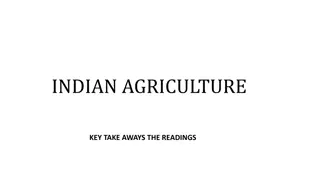Importance of Indian Agriculture in the Economy
Indian agriculture is a crucial sector contributing significantly to the country's GDP and employing a large portion of the workforce. With a focus on food grain production, the sector has shown positive growth, making India a leading global producer in various agricultural products. Despite challenges in market integration and information accessibility, the agriculture sector remains vital to India's economic backbone, with agriculture-based activities playing a significant role in the nation's income and exports.
Download Presentation

Please find below an Image/Link to download the presentation.
The content on the website is provided AS IS for your information and personal use only. It may not be sold, licensed, or shared on other websites without obtaining consent from the author.If you encounter any issues during the download, it is possible that the publisher has removed the file from their server.
You are allowed to download the files provided on this website for personal or commercial use, subject to the condition that they are used lawfully. All files are the property of their respective owners.
The content on the website is provided AS IS for your information and personal use only. It may not be sold, licensed, or shared on other websites without obtaining consent from the author.
E N D
Presentation Transcript
UNIT 1 JAHANAVI DEO B.COM PART 2 M.L ARYA COLLEGE KASBA
INDIAN AGRICULTURE Agriculture is the most important sector of Indian Economy. Indian agriculture sector accounts for 18 per cent of India's gross domestic product (GDP) and provides employment to 50% of the countries workforce. India is the world s largest producer of pulses, rice, wheat, spices and spice products
India has many areas to choose for business such as dairy, meat, poultry, fisheries and food grains etc. India has emerged as the second largest producer of fruits and vegetables in the world.
]. According to the data provided by Department of Economics and Statics (DES) the production of food grains for the year 2013-2014 is 264 million tons which is increased when compared to (2012-2013) 257million tons. This is a good symptom for the Indian economy from the agriculture sector. India remains among main three as far as production of different agricultural things like paddy, wheat, pulses, groundnut, rapeseeds, natural products, vegetables, sugarcane, tea, jute, cotton, tobacco leaves and so on. On the other hand, on advertising front, Indian agribusiness is as yet confronting the issues, for example, low level of business sector reconciliation and integration, availability of dependable and convenient information needed by farmers on different issues in farming .
Indian is an agriculture based country, where more than 50% of population is depend on agriculture. This structures the main source of income. The commitment of agribusiness in the national income in India is all the more, subsequently, it is said that agriculture in India is a backbone for Indian Economy. The contribution of agriculture in the initial two decades towards the total national output is between 48% and 60%. In the year 2001-2002, this contribution declined to just around 26%. The aggregate Share of Agriculture and Allied Sectors, Including agribusiness, domesticated animals, and ranger service and fishery sub segments as far as rate of GDP is 13.9 percent during 2013- 14 at 2004-05 prices. Agricultural exports constitute a fifth of the total exports of the country. In perspective of the overwhelming position of the Agricultural Sector, gathering and support of Agricultural Statistics expect incredible significance. According to the fourth Advance Estimates of Production of food grains for 2013-14, aggregate food grain production is assessed to be 264.77 million tons (MT). Export of spices from India are relied upon to reach US$ 3 billion by 2016- 17, on the back of imaginative promoting strategies, inventive bundling, quality in quality and an in number appropriation system. The Indian flavors business is pegged at Rs 40,000 crore (US$ 6.42 billion) every year, of which the marked portion represents 15% [3].
The National Food Security Mission (NFSM) was launched from Rabi, 2007-08. The fundamental targets of the National Food Security Mission (NFSM) is to expand production of rice, wheat, pulses and coarse cereals through region extension and efficiency upgrade in a supportable way in the recognized locale of the nation; restoring soil ripeness and profitability at the individual ranch level; and improving farm level economy (i.e. ranch benefits) to restore confidence amongst the farmers. The Mission met with a staggering achievement and accomplished the focused on extra generation of rice, wheat and heartbeats. The Mission is being kept amid Twelfth Five Year Plan with new focuses of extra generation of sustenance grains of 25 million tons including 10 million tons of rice, 8 million tons of wheat, 4 million tons of pulses and 3 million tons of coarse cereals by the end of twelfth five year plan.
Most of the Indians are directly or indirectly depending on the agriculture. Some are directly attached with the farming and some other people are involved in doing business with these goods. India has the capacity to produce the food grains which can make vast difference in Indian Economy. To achieve targeted mark by the government it needs to provide support in case of land, bank loans and other machineries to the small farmers along with the big farmers with this we can expect some improvement in Indian economy.

























